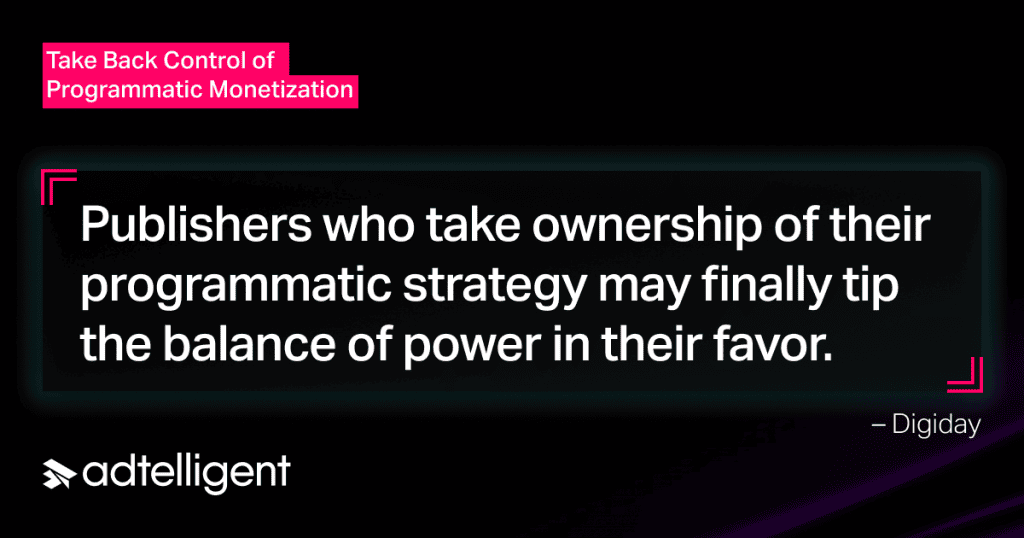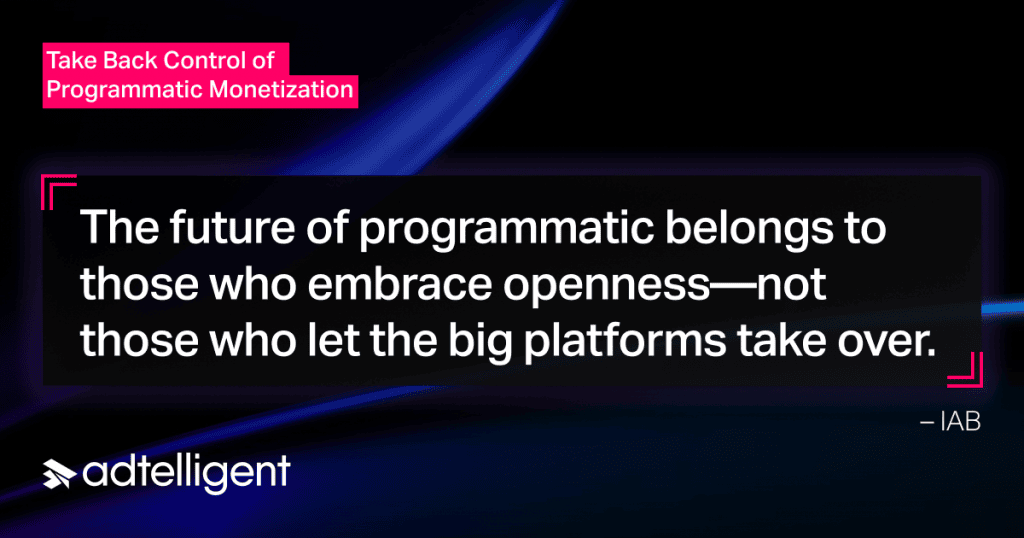For too long, publishers have relied on tech giants to power their programmatic advertising. But as these platforms tighten their grip on the digital ad ecosystem, it’s clear that true independence means taking back control. In 2025, the path forward is bringing ad tech operations in-house—owning the entire supply chain and making data-driven decisions without external gatekeepers.
Let’s look at some of the most crucial steps you should take in the direction of programmatic monetization aligned with the advertising trends 2025.
Why Publishers Must Take Charge
Bringing ad tech operations in-house gives media companies and website owners full control over every aspect of their advertising ecosystem—from placements and sales to analytics, fraud prevention, scoring, and data management.
End-to-End Transparency
Publishers need a clear view of who is buying their inventory, at what price, and through which partners. Owning the process ensures there are no blind spots and programmatic monetization works.
Direct Advertiser Relationships
Removing unnecessary intermediaries leads to higher margins, better ad quality, and direct partnerships with advertisers who value premium inventory.
Revenue Control
Managing both SSP and DSP in a unified ecosystem allows companies to track every dollar, ensure programmatic monetization, and make data-driven decisions for long-term growth.
What Does AdTech Community Think?
For years, sales houses relied on ad tech vendors to fix programmatic ad flaws, but 2025 marks a shift toward regaining control.
Some media agencies, like Justin Wohl, are cleaning up their ads.txt files, removing inefficient resellers, and reclaiming lost ad revenue. Others, like DPG Media, are moving away from Google’s tech stack, creating proprietary data platforms and buying tools to enhance ad performance.
Taking control isn’t easy—companies face revenue risks, legal challenges, and complex ad operations—but many see long-term gains in direct ad sales. Even with this shift, open market auctions still play a role, though website owners now prioritize high-quality inventory and strategic partnerships. The industry is realizing that small, deliberate actions—like optimizing supply chains—can improve transparency, efficiency, and profitability.

This growing movement suggests that publishers who take ownership of their programmatic strategy may finally tip the balance of power and programmatic monetization in their favor.
At IAB ALM 2025, experts stressed that the open web’s survival depends on keeping it open. But with restrictive ad placement policies and growing platform control, advertisers are finding it harder to ensure their ads appear in safe, high-quality spaces.
IAB CEO David Cohen compared today’s digital environment to past mistakes caused by isolationism. When competition disappears, innovation slows, and a few big players take control. If publishers don’t act now, they risk losing advertiser trust and being pushed out by closed platforms.

To stay ahead, publishers must focus on transparency, fair ad placement, and giving advertisers confidence in their campaigns. The future of programmatic belongs to those who embrace openness—not those who let the big platforms take over.
Key Steps to Take Back Control of Programmatic Monetization
Build Your Own Media Ecosystem
Media agencies now can create their own ad business models —self-sustaining advertising ecosystems where they control inventory, audience data, and partnerships. With first-party data, custom ad platforms, and private marketplaces (PMPs), they can reduce reliance on third-party ad networks and maximize revenue directly.
Prioritize Privacy-First Monetization
With GDPR, CCPA, and other privacy laws getting stricter, publishers need to move toward privacy-first advertising. The deprecation of third-party cookies in Chrome means that first-party data strategies and custom ad platforms are now essential.
For example, such technologies as Google’s Privacy Sandbox and Topics API are shaping the industry, but at the same time, they create dependency for their participants and users. Open-source tools or independent platforms, like id5, myGaru, and other privacy-centric platforms, offer more control and better partnerships without the risk of dependency. This shift will help publishers build a more secure and profitable future.
Fine-Tune Your Settings
To take control of their programmatic future, publishers need to manage and adjust their settings regularly. This includes everything from where ads appear, who sees them, and how revenue is optimized.
By customizing SSP and DSP settings, publishers can make sure ads are shown at the right times, to the right people, and in the right contexts. This leads to better ad quality, more effective targeting, and better use of first-party data.
Publishers should also keep their settings updated to stay aligned with industry best practices. By controlling these settings, publishers can increase revenue, reduce risks, and protect their brand.
Integrate Fraud Systems
Ad fraud is still a huge challenge, but smarter solutions are helping. By using verified demand sources and fraud prevention tools, website owners can ensure they’re showing real, high-quality ads and getting paid fairly.
Ad tech vendors can simplify adoption by offering plug-and-play solutions, step-by-step guides, and providing training, ongoing assistance, and real-world case studies. Real-time dashboards help clients track their exposure to invalid traffic (IVT) and make improvements as needed.
Also, having an integrated fraud system is key to blocking fake or irrelevant ads. When publishers use verified demand sources and fraud prevention tools, they ensure they’re only serving real, high-quality ads—and getting paid fairly.
Collaboration across the ecosystem is also key. Join industry initiatives like TAG, IAB, and IAB Tech Lab to align on best practices. Hold partners accountable by requiring certifications, audits, and transparency tools throughout the supply chain.
In the long run, though, full-cycle solutions will only become more and more vital in helping AdTech market participants protect their brands online.
The Power of an Integrated Programmatic Platform
To eliminate inefficiencies, publishers must adopt solutions that bring together:
- SSP + DSP in One Platform – An omnichannel seamless connection between supply and demand across all channels and devices, including popular formats like CTV, guarantees optimized revenue.
- First-Party Data Utilization – With cookies phasing out, companies must use their own audience data to attract premium advertisers.
- Private Marketplaces (PMPs) – Direct deals with advertisers ensure more predictable revenue and greater control over ad placements.
- Ad Creative Management – Easy ad placement and moderation offer high-quality, brand-safe advertising.
Taking Back Control
The programmatic ad landscape is complex, and keeping your monetization on track isn’t easy. But to succeed, website owners need to follow key trends, be more autonomous, ensure transparency, use smart automation and build strong partnerships.
Open-source and first-party solutions are a step in the right direction, but to truly maximize their benefits, you need a technology partner that prioritizes transparency and efficiency. The right platform should simplify your ad operations, connect you with reliable demand partners, and ensure you’re always getting a fair deal.
Taking control may seem like a big task, but with the right tools, it’s more achievable than you think.
Adtelligent’s white-label DSP platform gives publishers the power to eliminate hidden fees, optimize revenue, and maintain full transparency. The future of monetization belongs to those who own their programmatic stack. Start taking back control today.